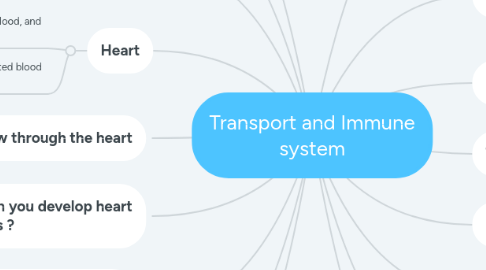
1. Transpiration
1.1. A water molecule is very small, and can easily pass through the cell membrane.
1.2. When the liquid water in the cells becomes vapor, it's called an evaporation.
1.2.1. The loss of water from the leaves is called a transpiration.
2. The factors of transpiration
2.1. When the temperature is higher.
2.1.1. the air is dry ( low humidity )
2.1.1.1. Increased temperature.
3. Transport in mammals
3.1. Circulatory system: It is formed from a system of tubes, that are made up of blood vessels.
3.1.1. The tubes are connected to a pump, heart, which forces the blood circulation
3.1.1.1. There are valves in the heart, that make sure that blood is circulating one direction
4. Heart
4.1. A muscular organ that pumps blood, and expands in size.
4.1.1. Arteries: Blood is pumped aways from the heart
4.1.1.1. Veins: Blood pumps towards the heart through veins
4.2. The left side pumps oxygenated blood around the rest of the body
4.2.1. The deoxygenated blood returns to the right side, to be sent to the lungs again.
5. Blood flow through the heart
5.1. 1. Blood from the body, starts from the vena cave and enters the right atrium
5.1.1. 2. Contraction of the right atrium
5.1.1.1. 3. Contraction of the right ventricle ventricle forces blood out through the pulmonary artery.
5.1.1.1.1. 4. Blood enters the left atrium, from the lungs
6. How can you develop heart diseases ?
6.1. The blockage of coronary arteries can cause health problems: For example, heart pains, high blood pressure etc
6.1.1. Factors that can increase the risk of blockage of coronary arteries,
6.1.1.1. Diet: High levels of satruarated fat in the diet.
6.1.1.1.1. Smoking: The chemicals can damage the smooth lining.
7. Plasma: This is a straw colored liquid part of the blood. It consists of water.
7.1. Red blood cell: Their main function is to carry oxygen around the body. Its attached to molecules of Haemoglobin.
7.1.1. White blood cells: There are many types of white blood cells. But they have an important role in defending our body from diseases. They are part of the immune system. They ingulf pathogens
7.1.1.1. Platelets: They have an important role for protecting us from infection as well.
8. Allergies: A reaction to certain plants animals foods
8.1. - fight ordinary things pollen or certain things
8.1.1. Symtoms: Sneezing, red eyes, itching
9. Measles
9.1. One of the world most contagious diseases.
9.1.1. Can be active in the air and surfaces for 2 hours
9.1.1.1. Symtoms: Fever, rash, complications ( blindness, brain swelling )
9.1.1.1.1. No anitviral treatment
10. In Plants
10.1. Xylem: A tissue, with long tubes that are hollow with dead cells. Carries, water and mineral throughout the plant
10.1.1. They are important for photoysnthesis
10.2. Phloem: They are living cells to form a phloem tissue. Dissolved food material, like sucrose or amino acids are formed in the leaf.
10.3. The xylem and Phloem are grouped together as Vascular bundles or veins.
11. Water up take
11.1. Plants absorb water and dissolved mineral ions from the soil through root hair cells.
11.1.1. The cell membranes of the root hair cells take in mineral ions, by active transport
11.2. They have an extension out of the soil, that increases it's surface area.
11.2.1. Root hair cells, can be very delicate. Therefore they can get easily damaged.
12. Different circulatory system
12.1. Fish, have only one type of circulatory system. This mean, that blood can travel through only once.
12.1.1. The mammalian circulatory is more complicated then fish. The blood travels through the heart twice.
13. The heart has 4 chambers
13.1. Two atria, single atrium, two ventricles,
13.1.1. The heart has it's own separate blood supply, to provide the muscle tissue with oxygen and glucose.
14. Heart rate
14.1. This is the measure of flow, how frequently the heart beats
14.1.1. Age: Children usually have a faster average than adults
14.1.1.1. Fitness: A trained athlete, can have a slower heart beat per minute. There is more contraction
15. Blood vessels
15.1. Arteries: Large blood vessels that carry blood, away from the heart
15.1.1. Capillaries: Tiny blood vessels that forms a network.
15.1.1.1. Veins: Large blood vessels that carry blood that is flowing back to the heart.
